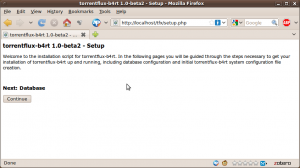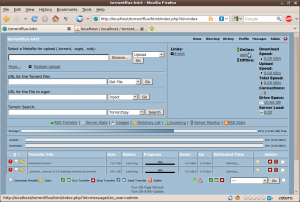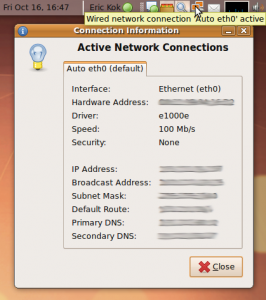Here are the steps to install Transdroid when you use Torrentflux-b4rt on Ubuntu:
Setting up Torrentflux-b4rt
Torrentflux-b4rt is web application used to control torrents (with a Torrentflux or Transmission backend) and other download types. Although it is pretty old and ill-maintained now, it is still popular because of extensive multi-user features.
To install Torrentflux-b4rt on a Ubuntu machine, you need the latest Torrentflux-b4rt 1.0 version available at the official download site. I assume you already have a working web server. If not, installation is easy. Now unpack the downloaded Torrentflux-b4rt archive. You should now have a set of folders, one of them called ‘html’. Copy this folder to your web server root and then rename it to ‘torrentflux’. You will need superuser rights for that. In a terminal, you may use the command ‘sudo mv /path/to/extracted/archive/html /var/www/torrentflux’, where you give the correct path to the extracted archive. The default root directory for an Apache web server is at /var/www on Ubuntu.
Now a last setup is needed. Open a browser and go to http://localhost/torrentflux/setup.php. (I assume you placed the files in a ‘torrentflux’ directory that resides in the root as explained above.)
The setup script is pretty simple. Ideally you would want to create a separate database user for Torrentflux-b4rt to use, but at least you need your MySQL root user password. Don’t forget to remove the setup.php script fter your done installing.
Allow access from anywhere
The next step is very important if you want to use Transdroid to control Torrentflux-b4rt from anywhere you go and not just your home Wi-Fi network. You will need to open up the port 80 and redirect this to your home computer. Now if you already had a running webserver, most likely you already did this earlier. If not, read on.
First get your Ubuntu computer’s IP address. Right-click on the connections icons in the top panel; this is the NetworkManager Applet. If choose ‘Connection Information’ it will give you some statistics about your current computer’s network connection. You need the number that says ‘IP Address’. Note it down or remember it: this is your computer local IP address.
Now go to your the manager interface of your router or ADSL modem. It will most likely have a NAT tab or settings screen. Here you will need to set up a port forward from all external traffic on port number 80 to you local computers’ IP address – the one that you just retrieved from the Ubuntu connection manager – on the same port. There are too many routers and ADSL modems to make detailed explanations here, but you can use the website PortForward for in-depth help.
Setting up Transdroid
The final step is to set up Transdroid. Install the software from the Android Market and open up the application. You will see a message that you need to set up a server configuration first. Hit your Android device’s menu button and choose ‘Settings’. Next, click the ‘Add a server’ button to create your first server configuration. You can add more later, if you need to.
Now fill in all the settings. The name is totally up to you. From the type menu you choose for Torrentflux-b4rt of course.
The IP address is your server’s external IP address. If you do not know this, open up a browser on your Ubuntu machine and surf to whatismyip.com. It will present you the external IP address that you need in Transdroid.
The port number is the next setting and is 80. (It is possible to set up Torrentflux-b4rt on a different port, for example with SSL on 443, but that is out of the scope of this guide.)
Enable the authentication setting and fill out the username and password that you created for yourself during the Torrentflux-b4rt setup.
Time to test your settings! First disconnect from the Wi-Fi network if you are connected to the local network (the one where your Ubuntu machine is in as well). This is important, because you will need to use different settings for that.
Now, hit the back button of your Android device twice to return to the main screen. It should now state that it is connecting to the sever. After a couple of seconds you should get a listing of all the active torrents in Torrentflux-b4rt. Reward yourself by downloading some torrents, right from your phone. 🙂
Local Wi-Fi network access
One thing you should know when you have a Wi-Fi network at home, is that you cannot use your external IP address as described above while you are connected this way. When connected to the wireless network that your Ubuntu machine is in, you will need to use your machine’s internal IP address instead.
Easiest thing to do is to open Transdroid’s settings menu again and add a new sever configuration. Use the exact same details that you used before, but now use your Ubuntu machine’s local IP address. Of course you also want to give it a name that identifies it as being your local configuration.
Give it a test by going to the main screen and choose ‘servers‘ from the menu. You can select the other configuration from the pop-up menu. A little tip: switching servers can also be done by swiping your finger from left to right (or the other way around). No need to open the menu each time!
Troubleshooting
If Transdroid refuses to connect you, use these steps to trace the problem.
First try to log in to Torrentflux-b4rt from your Ubuntu machine directly, using http://127.0.0.1/torrentflux. If you get a page not found error, you have placed the Torrentflux-b4rt html files in a different folder or the web server cannot access the files. As long as you cannot even access Torrentflux-b4rt directly, Transdroid will not work as well.
If this direct connection works, check if you can connect using Transdroid while connected on your internal Wi-Fi network. Remember to use you internal IP address now. If this works but external connections via 3G/EDGE don’t, you have not set up the port forwarding correctly.
Still having troubles? Use the ‘error report’ feature in Transdroid’s menu to get personal help.
Good luck and enjoy!



I am trying to connect Transdroid to my Torrentflux server. The Server is CentOS5 not Ubuntu, should that matter?
The address is http://xserv.rnmacleod.ca/torflux/html/
whenever Transdroid trys to connect it gets back “Error Parsing Server response”
I have entered all the information correctly. It shows it trying to connect to http://piper@xserv.rnmacleod.ca:80/torflux/html/
That seems all right. What version of Torrentflux are you using? Could you send me an error report using the menu item in Transdroid? If possible, please send the XML output of /torflux/html/stats.php?t=all Thanks!
Awesome.
it seems that i can’t upload torrent with transdroid on b4rt’s tf, is it working as expected ?
As far as I know, this should work. Can you send me an error report? What version are you using?